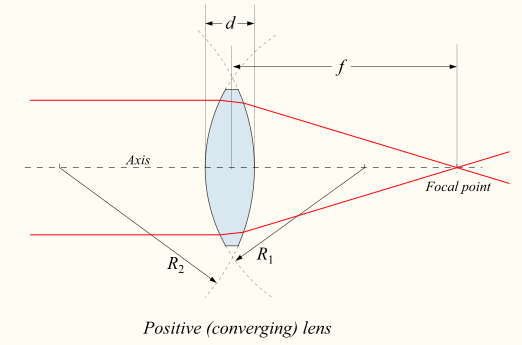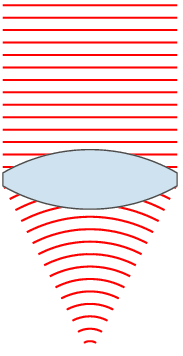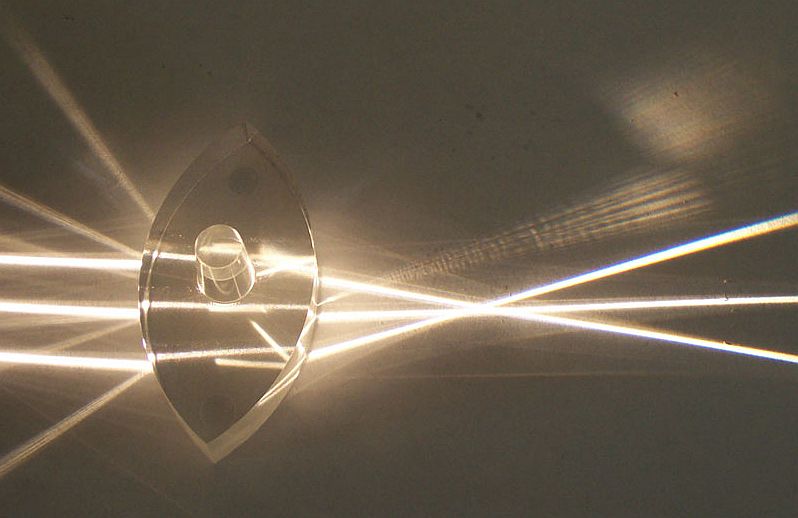人類是使用符號的動物,故而能以語言、文字表述宇宙人生之萬象 。然而這並非不學而能的事,實是成長學習過程中,日積月累之功 。因此運用『矩陣光學』符號,展現『幾何光學』事理,不如想像之簡單容易,一般還得努力練習的哩?好處是熟悉之後對於『幾何光學』之理解也自然深化的了!
茲舉何謂『焦距』乙事,談談『平行光成像』之理︰



若問什麼是『平行光』?它與什麼『平行』的呢??一束『平行』之光線,可用 ![]() ,這裡
,這裡 ![]() 表示距離『光軸』的高度,視為此束『平行光』之參數變元;那個
表示距離『光軸』的高度,視為此束『平行光』之參數變元;那個 ![]() 是此光束與『光軸』形成的夾角,因此為此束『平行光』之常數常元。因是『平行光』說其自身光線彼此平行而已。
是此光束與『光軸』形成的夾角,因此為此束『平行光』之常數常元。因是『平行光』說其自身光線彼此平行而已。
【參考資料】
class sympy.physics.optics.gaussopt.GeometricRay
Representation for a geometric ray in the Ray Transfer Matrix formalism.
| Parameters : |
h : height, and angle : angle, or matrix : a 2×1 matrix (Matrix(2, 1, [height, angle])) |
|---|
See also
Examples
>>> from sympy.physics.optics import GeometricRay, FreeSpace
>>> from sympy import symbols, Matrix
>>> d, h, angle = symbols('d, h, angle')
>>> GeometricRay(h, angle)
Matrix([
[ h],
[angle]])
>>> FreeSpace(d)*GeometricRay(h, angle)
Matrix([
[angle*d + h],
[ angle]])
>>> GeometricRay( Matrix( ((h,), (angle,)) ) )
Matrix([
[ h],
[angle]])
angle
The angle with the optical axis.
Examples
>>> from sympy.physics.optics import GeometricRay
>>> from sympy import symbols
>>> h, angle = symbols('h, angle')
>>> gRay = GeometricRay(h, angle)
>>> gRay.angle
angle
height
The distance from the optical axis.
Examples
>>> from sympy.physics.optics import GeometricRay
>>> from sympy import symbols
>>> h, angle = symbols('h, angle')
>>> gRay = GeometricRay(h, angle)
>>> gRay.height
h
如此就一個『焦距』為 ![]() 的『薄透鏡』
的『薄透鏡』
![]()
,意味著與『光軸平行』之『平行光』 ![]() 行經此『薄透鏡』後 ,將在離『薄透鏡』
行經此『薄透鏡』後 ,將在離『薄透鏡』 ![]() 處『聚焦』,此點稱之為『焦點』 。看來清楚明白之事,數理解析上要如何陳述此理耶?設想此束『平行光』剛過『薄透鏡』即將折屈,一段距離
處『聚焦』,此點稱之為『焦點』 。看來清楚明白之事,數理解析上要如何陳述此理耶?設想此束『平行光』剛過『薄透鏡』即將折屈,一段距離 ![]() 後,整束光會交匯於一點,也就是說此點存在且和
後,整束光會交匯於一點,也就是說此點存在且和 ![]() 無關也!且用 Sympy 工具幫忙運算一番︰
無關也!且用 Sympy 工具幫忙運算一番︰
pi@raspberrypi:~h \cdot \left( 1 - \frac{z}{f} \right) + z \cdot \theta
z = f
h
\theta = 0
0
f
(0, \theta)$,將會如何的阿?讀者自可解讀的吧︰
In [16]: 前焦點現象 = (薄透鏡 * 行經距離Z).subs(z, f) In [17]: 前焦點現象 Out[17]: ⎡ 1 f⎤ ⎢ ⎥ ⎢-1 ⎥ ⎢─── 0⎥ ⎣ f ⎦ In [18]: 方將通過前焦點之任意光線 = GeometricRay(0, θ) In [19]: 方將通過前焦點之任意光線 Out[19]: ⎡0⎤ ⎢ ⎥ ⎣θ⎦ In [20]: 前焦點現象 * 方將通過前焦點之任意光線 Out[20]: ⎡f⋅θ⎤ ⎢ ⎥ ⎣ 0 ⎦ In [21]: